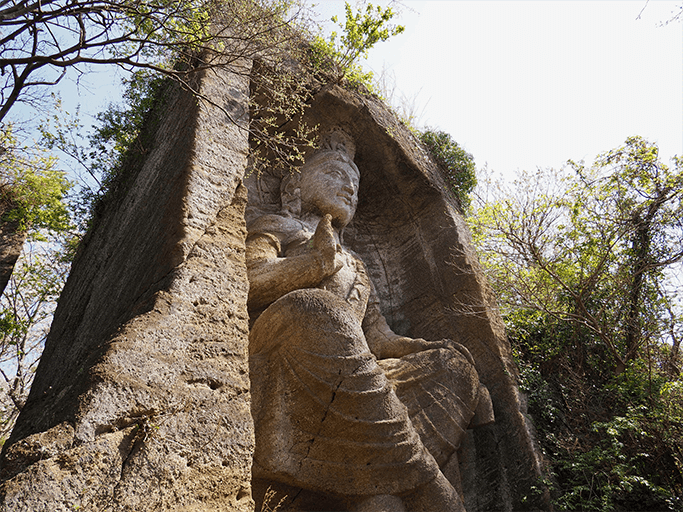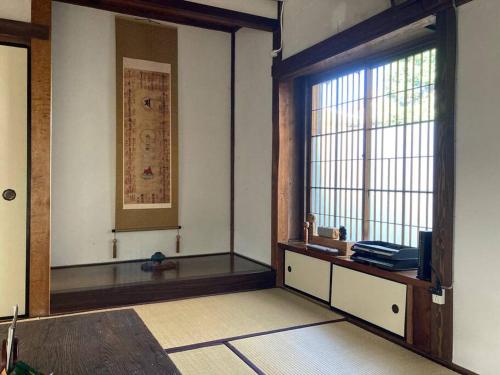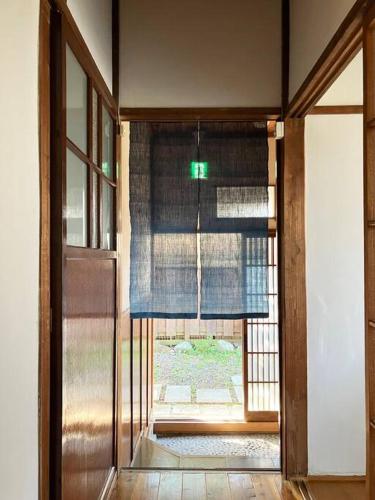
Mount Takatori in Yokosuka, located right where the Miura Peninsula connects to the mainland, is a moderate half-day hike with plenty to see along the way: Jinmuji temple, a sheer cliff at the peak popular among rock-climbers, and a huge stone bodhisattva carved into the mountainside. The observation tower at the peak also has great views across Sagami Bay.
If you’re coming from Tokyo, one easy starting point is Higashi-Zushi Station on the JR Yokosuka Line, roughly 80 minutes from Tokyo Station. From the station, head north along the main road for 5 or 10 minutes until you see a stone staircase leading upward to the right, marked by a huge stone pillar that says “Jinmuji Temple” plus a white sign with a bright red arrow that reads “Jinmuji Temple/Mount Takatori Trailhead” (all in Japanese). Climb the stairs past the houses, and you’ll be at the trailhead in a few minutes. You can also reach the trailhead from Jinmuji Station on the Keikyu Zushi Line, off to the west.
-
![The stairway to the Mount Takatori trailhead, including signage.]()
The stairway to the Mount Takatori trailhead, including signage.
-
02
Konpira Yagura: Caves in the Hillside
The first site of interest along the trail is the Mount Konpira Yagura Group. Yagura are artificial cave in a hillside. They were originally used to inter bones after cremation, but later served as remains-free memorial sites, and after that were sometimes repurposed for storage. There are thousands of them in Kamakura and the surrounding areas, mostly created during or shortly after the Kamakura Period (1185–1333).
According to the sign on the trail, the Mount Konpira Yagura Group includes just over two dozen caves dating from around the fourteenth century. Unfortunately, the caves were hastily cleared out during the Second World War without a detailed archaeological survey, so it’s not clear who was originally interred there. The empty caves remain, though, overgrown with grass and weeds, an object lesson in the passage of time. (At least until your kids tell you to get a move on and stop contemplating mortality.)![Peering into history at the Mount Konpira Yagura Group.]()
Peering into history at the Mount Konpira Yagura Group.
-
03
History and Squirrels at Jinmuji Temple
The next stop on the trail is Jinmuji Temple, a peaceful but impressive complex among the trees. (The forest here, incidentally, is supposed to have been relatively unchanged for thousands of years, and has an extremely healthy squirrel population.) Jinmuji’s own temple history states that it was founded in the eight century by the renowned priest Gyoki. Historians haven’t been able to corroborate this independently, but it does make an appearance in the Kamakura-era chronicle Azuma Kagami, so it’s certainly been on the site a long time.
Jinmuji’s Yakushido Hall was first built in 1599, and it’s home to a woodland Elaeocarpus tree estimated to be around four centuries old. This has the charming name of Nanja Monja, roughly “Whatchamacallit”—whoever chose the name evidently wasn’t familiar with the woodland Elaeocarpus as a species. The temple bell was long considered one of the “Eight Sights of Zushi”, and still tolls when evening falls.![Yakushido Hall. Quercus acuta, CC BY-SA 4.0, via Wikimedia Commons]()
Yakushido Hall. Quercus acuta, CC BY-SA 4.0, via Wikimedia Commons
-
04
At the Peak: Rock-Climbers and Stone Sculptures
Beyond Jinmuji, the hike gets more adventurous, with paths through high walls of stone and some steep slopes with chains to hold as you climb. Half an hour or so of this will bring you to the mountaintop. This was used as a quarry from the late 1800s into the mid-1900s, and this is obvious from the exposed walls of tuff. One particularly tall and sheer drop is usually in use by a handful of rock-climbers. (Sadly, climbing without the blessing of the Mount Takatori Safe Rock Climbing Association is strictly forbidden, so don’t bother to bring your own gear.)
![Just reaching the top of Mount Takatori. A highly distinctive look.]()
Just reaching the top of Mount Takatori. A highly distinctive look.
The very peak of the mountain, 138 meters above sea level—it feels higher in a coastal area like Yokosuka!—has an observation tower with the usual magnificent views of the surrounding area. If the weather cooperates, you’ll be able to see Chiba to the East, Mount Fuji to the west, and even Tokyo Skytree to the north.
![Looking southeast from the observation tower. Quercus acuta, CC BY-SA 4.0, via Wikimedia Commons]()
Looking southeast from the observation tower. Quercus acuta, CC BY-SA 4.0, via Wikimedia Commons
You might also notice an elementary school right near the mountaintop, which can feel a bit deflating after making a one-hour climb to get there. It turns out that the eastern side of the mountain is a well-developed residential area.
![An elementary school right near the mountaintop, with Tokyo Bay in the distance beyond.
Quercus acuta, CC BY-SA 4.0, via Wikimedia Commons]()
An elementary school right near the mountaintop, with Tokyo Bay in the distance beyond. Quercus acuta, CC BY-SA 4.0, via Wikimedia Commons
Descending from the observation tower, you’ll notice a path leading between the rock walls to the east. Five or ten minutes down this path is an eight-meter sculpture of the bodhisattva Miroku (Maitreya), carved directly into a rock wall by local sculptor Shigeru Fujishima in the early 1960s. A little exploration will turn up other, even more recent Buddhist carvings here and there, some even painted.
![Shigeru Fujishima’s sculpture of Maitreya. (The wasp’s nest is a more recent addition.)]()
Shigeru Fujishima’s sculpture of Maitreya. (The wasp’s nest is a more recent addition.)
- Magaibutsu
-
-
- Kanagawa Yokosuka-shi Shonantakatori 3-3-520 (Takatoriyama Park)
-
-
-
- 0468228333
-
View AllOnce you’ve seen the sights and perhaps enjoyed a picnic at the peak, you can either return the way you came to Higashi-Zushi or Jinmuji station in the west, or head northwest through the town to Oppama Station, roughly 45 minutes away.
- Takatoriyama Park
-
-
- Kanagawa Pref. Yokosukashi Shounantakatori 3-3-520
-
-
-
- 0468228333
-
-
-
- All day
-
View All桜山ノウチ
桜山2丁目2-6 Kamakura









 Go here
Go here











